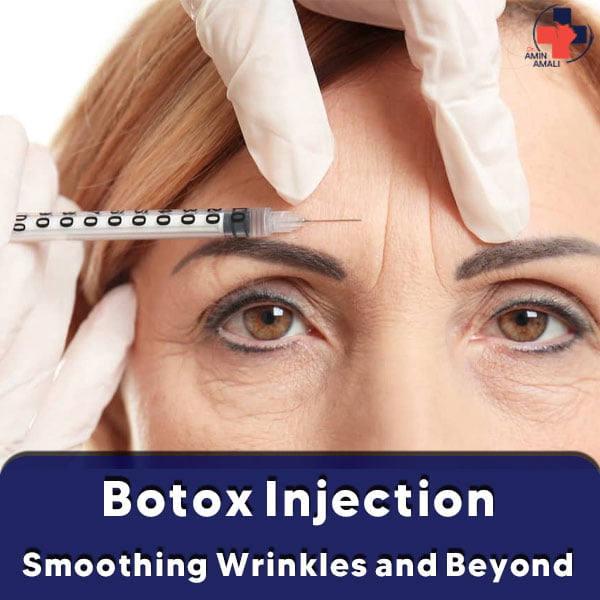Botox injection , a popular cosmetic procedure, has become synonymous with reducing wrinkles and achieving a youthful appearance. But Botox offers more than just aesthetic benefits. This article delves into the world of Botox injections, exploring its uses, how it works, what to expect during treatment, and recovery.

Understanding Botox: A Muscle Relaxer, Not a Filler
Botox (OnabotulinumtoxinA) is a purified protein derived from a bacterium. Contrary to popular belief, it’s not a filler. Instead, Botox works by temporarily blocking nerve signals to targeted muscles. This relaxation smooths wrinkles caused by repeated muscle contractions, particularly frown lines, forehead lines, and crow’s feet around the eyes.
Beyond Cosmetics: Therapeutic Applications of Botox
While known for its cosmetic applications, Botox offers therapeutic benefits for various medical conditions:
- Chronic Migraines: Botox injections can significantly reduce migraine frequency and intensity.
- Muscle Spasms: Botox helps manage muscle stiffness and spasms in conditions like cervical dystonia (neck pain) and hemifacial spasm (facial twitching).
- Excessive Sweating (Hyperhidrosis): Botox injections can effectively control excessive sweating in areas like the underarms, palms, and soles of the feet.
- Overactive Bladder: Botox injections into the bladder muscles can improve bladder control in patients with urinary incontinence.
- Eye Disorders: Botox can treat uncontrolled blinking (blepharospasm) and strabismus (crossed eyes).
The Botox Injection Process
A Botox injection procedure is typically a simple and outpatient process:
- Consultation: A consultation with a qualified healthcare professional, like a dermatologist or plastic surgeon, is crucial. They will discuss your goals, medical history, and assess if Botox is suitable for you.
- The Procedure: During the injection, a small amount of Botox is precisely injected into targeted muscles using a fine needle. The discomfort is minimal, and topical anesthetic cream might be used for further comfort.
- Recovery: Downtime is minimal. You might experience mild redness, swelling, or bruising at the injection site, which usually resolves within a few days.
Botox Results and Longevity
The visible effects of Botox injections typically take 3-7 days to appear and can last for 3-4 months. Following this, muscle function gradually returns, and repeat injections are needed to maintain results.
Considering Botox? Here’s What to Ask
If you’re considering Botox injections, here are some key questions to discuss with your doctor:
- Am I a good candidate for Botox?
- How many units of Botox will I need? (Dosage can vary depending on the area treated and desired results)
- What are the potential side effects? (Common side effects include temporary injection site pain, redness, swelling, and headache)
- What are the costs involved? (Botox is typically not covered by insurance for cosmetic purposes)
Is Botox Safe?
Botox injections are a safe and effective treatment when performed by a qualified healthcare professional. Choosing an experienced doctor with a good understanding of facial anatomy and muscle function is vital.
Botox Aftercare Tips
- Avoid touching or rubbing the injection sites for a few hours.
- Avoid strenuous exercise for 24 hours.
- Avoid lying flat for several hours.
Possible Botox Side effects
Botox injections are a popular cosmetic procedure for reducing wrinkles and a treatment for various medical conditions. While generally safe when performed by a qualified professional, Botox can cause side effects. This article explores potential side effects, helping you navigate the post-injection experience.
Most Botox side effects are temporary and mild, resolving within a few days. They often occur near the injection site and can be categorized as:
- Injection Site Reactions: Redness, swelling, bruising, and minor discomfort are common. Applying ice packs can help reduce swelling.
- Flu-like Symptoms: Headache, fatigue, and body aches can occur in some individuals. Over-the-counter pain relievers can usually manage these.
- Temporary Facial Drooping: Unintended drooping of an eyelid or eyebrow (ptosis) can happen if Botox affects nearby muscles. This is usually temporary and resolves within a few weeks.
Less Common, But More Serious Side Effects
While rare, more serious side effects require immediate medical attention. Seek help if you experience:
- Vision problems: Blurred vision, double vision, or drooping eyelids can indicate Botox migration beyond the intended area.
- Trouble breathing or swallowing: These are serious complications requiring immediate medical attention.
- Signs of Allergic Reaction: Hives, swelling of the face, lips, or tongue, and difficulty breathing require emergency medical attention.
Factors Affecting Side Effects
Several factors can influence the likelihood and severity of side effects:
- Injection Technique: A skilled and experienced healthcare professional can minimize the risk of complications and unintended effects.
- Dosage: Using the appropriate dose for the targeted area reduces the risk of Botox affecting unintended muscles.
- Individual Sensitivity: Some people are more prone to experiencing side effects than others.
Botox injections offer a non-surgical way to address wrinkles and certain medical conditions. It’s important to have realistic expectations. Botox won’t erase all wrinkles or freeze your face completely. However, it can provide noticeable improvements, boost confidence, and enhance your natural beauty.












